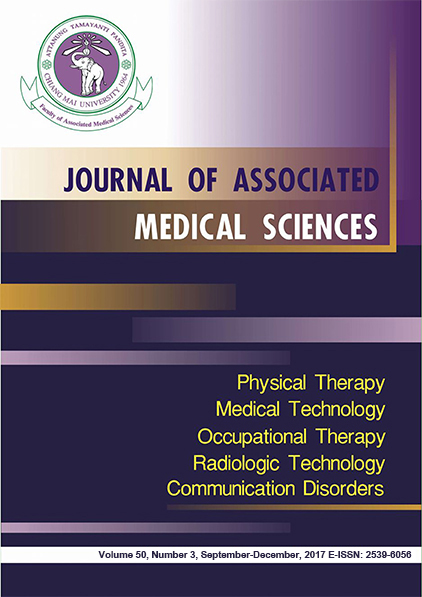Muscle thickness of serratus anterior muscle during performing wall push-up plus and standard push-up plus using ultrasound imaging
Main Article Content
Abstract
Background: Serratus anterior exercise is an important rehabilitation program in clinical practices. Different positions may affect muscle activity. However, there has no report investigating the thickness of serratus anterior during contraction in different positions.
Objectives: To investigate thickness of serratus anterior muscle at rest compare to during performing wall push-up plus and standard push-up plus.
Materials and methods: Twenty healthy male volunteers were participated. Thickness of right serratus anterior muscles was measured using ultrasound under three conditions: at rest, wall push-up plus and standard push-up plus. Each condition was repeated three times. Each image of serratus anterior muscle was measured three times by Image J software.
Results: Thickness of serratus anterior muscle during performing wall push-up plus and standard push-up plus were greater than at rest (p<0.001). There was no significant difference in thickness of serratus anterior muscle between wall push-up plus and standard push-up plus positions (p>0.05).
Conclusion: Thickness of serratus anterior muscle during performing wall push up plus and standard push up is not different. This suggests that both wall push-up plus and standard push-up can be applied to enhance performance of serratus anterior muscle.
Article Details
Personal views expressed by the contributors in their articles are not necessarily those of the Journal of Associated Medical Sciences, Faculty of Associated Medical Sciences, Chiang Mai University.
References
2. Lin JJ, Hanten WP, Olson SL, Roddey TS, Soto-quijano DA, Lim HK, et al. Functional activity characteristics of individuals with shoulder dysfunctions. J Electromyogr Kinesiol 2005; 15: 576-86.
3. Mell AG, LaScalza S, Guffey P, Ray J, Maciejewski M, Carpenter JE, et al. Effect of rotator cuff pathology on shoulder rhythm. J Shoulder Elbow Surg 2005; 14: 58S-64S.
4. Helgadottir H, Kristjansson E, Einarsson E, Karduna A, Jonsson H, Jr. Altered activity of the serratus anterior during unilateral arm elevation in patients with cervical disorders. J Electromyogr Kinesiol 2011; 21: 947-53. doi: 10.1016/j.jelekin.2011.07.007.
5. Bohannon RW. Manual muscle testing: does it meet the standards of an adequate screening test? Clin Rehabil 2005; 19: 662-7.
6. Moseley JB, Jr., Jobe FW, Pink M, Perry J, Tibone J. EMG analysis of the scapular muscles during a shoulder rehabilitation program. Am J Sports Med 1992; 20: 128-34.
7. Decker MJ, Tokish JM, Ellis HB, Torry MR, Hawkins RJ. Subscapularis muscle activity during selected rehabilitation exercises. Am J Sports Med 2003; 31: 126-34.
8. Sipila S, Suominen H. Quantitative ultrasonography of muscle: detection of adaptations to training in elderly women. Arch Phys Med Rehabil 1996; 77: 1173-8.
9. Talbott NR, Witt DW. Ultrasound imaging of the serratus anterior muscle at rest and during contraction. Clin Physiol Funct Imaging 2013; 33: 192-200.
10. Freeman S, Karpowicz A, Gray J, McGill S. Quantifying muscle patterns and spine load during various forms of the push-up. Med Sci Sports Exerc 2006; 38: 570-7.
11. Ludewig PM, Hoff MS, Osowski EE, Meschke SA, Rundquist PJ. Relative balance of serratus anterior and upper trapezius muscle activity during push-up exercises. Am J Sports Med 2004; 32: 484-93.
12. Uthaikhup S, Wannaprom N, Kummaung P. Effects of gender and hand dominance on size of the lower trapezius muscle. Muscle Nerve 2015; 52: 576-9.
13. Talbott NR, Witt DW. Ultrasound examination of the serratus anterior during scapular protraction in asymptomatic individuals: reliability and changes with contraction. PM&R 2014; 6: 227-34.
14. Kawsoiy K, Uthaikhup S. Intra-and inter-rater reliability of ultrasound imaging of the lower trapezius muscle thickness. J Med Tech Phy Ther 2014; 26: 180-3.
15. Castelein B, Cagnie B, Parlevliet T, Cools A. Serratus anterior or pectoralis minor: Which muscle has the upper hand during protraction exercises? Man Ther 2016; 22: 158-64.
16. Hodges PW, Pengel LH, Herbert RD, Gandevia SC. Measurement of muscle contraction with ultrasound imaging. Muscle Nerve 2003; 27: 682-92.


